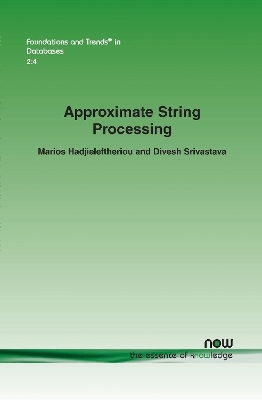
Approximate String Processing
Seiten
2011
now publishers Inc (Verlag)
978-1-60198-418-0 (ISBN)
now publishers Inc (Verlag)
978-1-60198-418-0 (ISBN)
Focuses specifically on the problem of approximate string matching and surveys indexing techniques and algorithms specifically designed for this purpose. The book concentrates on inverted indexes, filtering techniques, and tree data structures that can be used to evaluate a variety of set based and edit based similarity functions.
One of the most important primitive data types in modern data processing is text. Text data are known to have a variety of inconsistencies (e.g., spelling mistakes and representational variations). For that reason, there exists a large body of literature related to approximate processing of text.
Approximate String Processing focuses specifically on the problem of approximate string matching and surveys indexing techniques and algorithms specifically designed for this purpose. It concentrates on inverted indexes, filtering techniques, and tree data structures that can be used to evaluate a variety of set based and edit based similarity functions. The focus is on all-match and top-k flavors of selection and join queries, and it discusses the applicability, advantages and disadvantages of each technique for every query type.
The book is organized into nine chapters. Sandwiched between the Introduction and Conclusion, Chapters 2 to 5 discuss in detail the fundamental primitives that characterize any approximate string matching indexing technique. The next three chapters, 6 to 9, are dedicated to specialized indexing techniques and algorithms for approximate string matching.
One of the most important primitive data types in modern data processing is text. Text data are known to have a variety of inconsistencies (e.g., spelling mistakes and representational variations). For that reason, there exists a large body of literature related to approximate processing of text.
Approximate String Processing focuses specifically on the problem of approximate string matching and surveys indexing techniques and algorithms specifically designed for this purpose. It concentrates on inverted indexes, filtering techniques, and tree data structures that can be used to evaluate a variety of set based and edit based similarity functions. The focus is on all-match and top-k flavors of selection and join queries, and it discusses the applicability, advantages and disadvantages of each technique for every query type.
The book is organized into nine chapters. Sandwiched between the Introduction and Conclusion, Chapters 2 to 5 discuss in detail the fundamental primitives that characterize any approximate string matching indexing technique. The next three chapters, 6 to 9, are dedicated to specialized indexing techniques and algorithms for approximate string matching.
1: Introduction 2: String Similarity Functions 3: String Tokenization 4: Query Types 5: Index Structures 6: Algorithms for Set Based Similarity Using Inverted Indexes 7: Algorithms for Set Based Similarity Using Filtering Techniques 8: Algorithms for Edit Based Similarity 9: Conclusion. Acknowledgements. References
| Erscheint lt. Verlag | 22.2.2011 |
|---|---|
| Reihe/Serie | Foundations and Trends® in Databases |
| Verlagsort | Hanover |
| Sprache | englisch |
| Maße | 156 x 234 mm |
| Gewicht | 224 g |
| Themenwelt | Mathematik / Informatik ► Informatik ► Datenbanken |
| Informatik ► Office Programme ► Outlook | |
| Mathematik / Informatik ► Informatik ► Software Entwicklung | |
| ISBN-10 | 1-60198-418-9 / 1601984189 |
| ISBN-13 | 978-1-60198-418-0 / 9781601984180 |
| Zustand | Neuware |
| Haben Sie eine Frage zum Produkt? |
Mehr entdecken
aus dem Bereich
aus dem Bereich
Buch | Softcover (2022)
Markt + Technik Verlag
14,95 €


